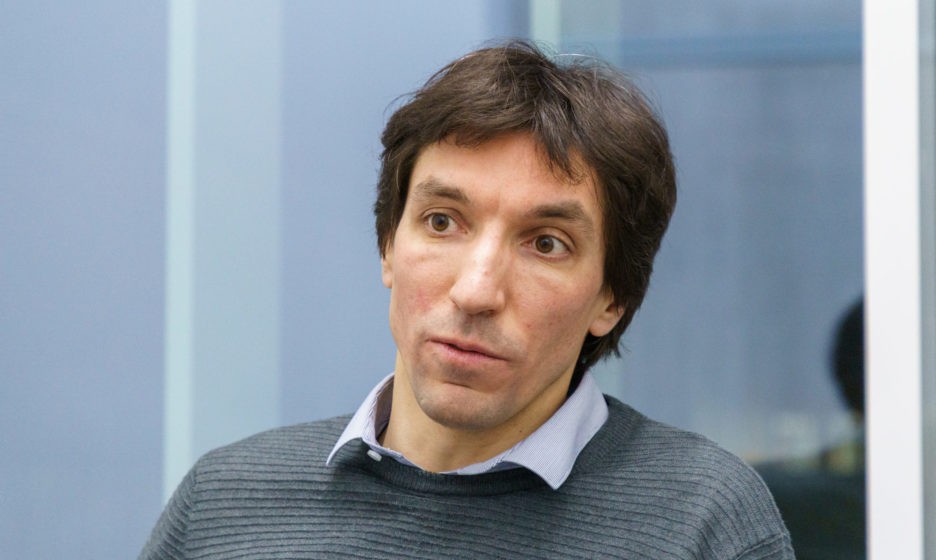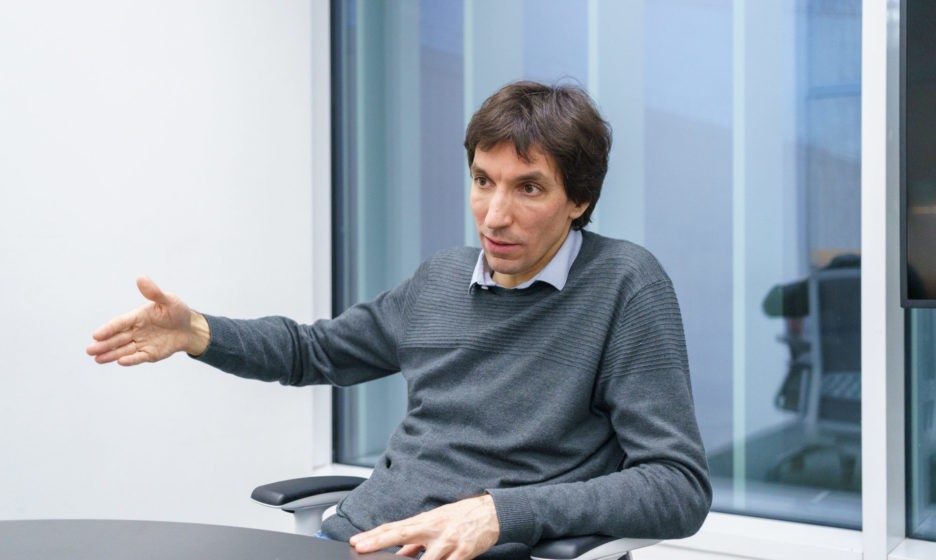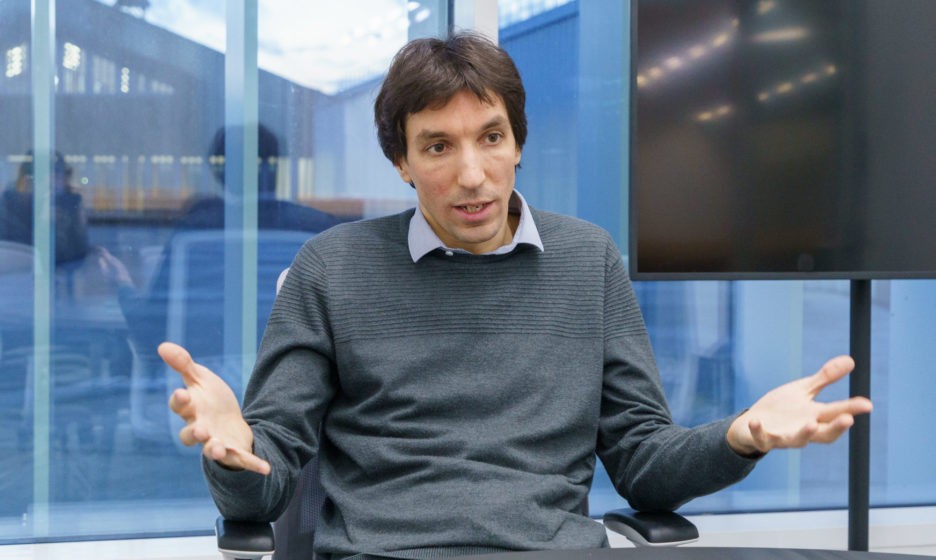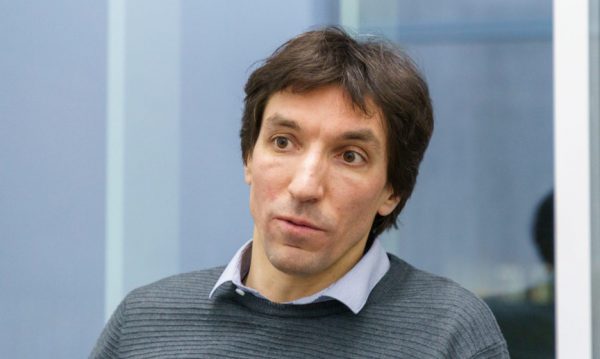 Doctor of Biological Sciences, PhD at Princeton University, Skoltech Professor, Head of the Laboratory of Molecular Evolution at the Institute for Information Transmission Problems of the Russian Academy of Sciences, molecular virologist Georgiy Bazykin answers Pravmir’s questions about SARS-CoV-2. How did the coronavirus spread in Russia, mutate, transmit in the community and within hospitals, how timely were social measures taken and should we fear a “second wave”?
Doctor of Biological Sciences, PhD at Princeton University, Skoltech Professor, Head of the Laboratory of Molecular Evolution at the Institute for Information Transmission Problems of the Russian Academy of Sciences, molecular virologist Georgiy Bazykin answers Pravmir’s questions about SARS-CoV-2. How did the coronavirus spread in Russia, mutate, transmit in the community and within hospitals, how timely were social measures taken and should we fear a “second wave”?
— Viruses are believed to become less deadly and more infectious over time. Is this what is happening now?
— Firstly, I would not say that viruses always evolve to less lethality. There is a huge body of research on this topic and no single answer. The virus “wants” to move from one carrier to another as quickly as possible, in the sense that natural selection promotes those mutations that increase its infectivity. What happens to the person who is infected is not so important to the virus.
We have seen viruses of very different mortality and very different infectivity. For example, smallpox has been with us for many centuries, and during this time no evolution towards lower mortality has happened. The human immunodeficiency virus has been with us for almost a century, and it has not gained any reduction in mortality by itself either; the situation is only mitigated by the new medications. So, in theory, we do not expect that the new coronavirus will necessarily develop lower mortality.

In practice, very little time has passed. This virus is constantly mutating (although not as quickly as, for example, influenza or the HIV), but it still has not accumulated a sufficient number of mutations. Therefore, even if it increased its infectivity or decreased its lethality, we might simply not see it yet.
— What surprised you personally during the observation of this virus? What has changed in your professional life?
— It is hard to single out just one fact. All the basic properties of this virus were understood more or less immediately. And it was immediately clear that the virus posed a great threat. But I had to work in real time like never before.
Since the previous interview with you, I have spent a lot of time on conventional, rather than molecular, epidemiology. Our group has been modeling how the number of cases in Russian regions will increase or decrease, depending on the measures taken. We have been doing this at the request of government agencies and worked in the black box mode, figuratively speaking. We sent government bodies our reports and did not receive any feedback. We could tell that they followed our recommendations only from the news. It’s very difficult to work like that. I’d like to see some results of my work.
In parallel, we were studying the molecular and genomic epidemic properties of this virus, also relying on Russian data. We managed to establish a very fruitful cooperation with the Influenza Institute that has a huge number of samples with detailed data collected on them. We do not know the names of the carriers because the data is anonymized, but we know their gender, age, and—most importantly—the history of their trips. This information was very useful to us.
Who infected us and who we infected
— What conclusions have you made?
— It turns out that the virus was not brought to us from China. The fact that Russia closed the land border with China early—on January 31—must have played a role here. The number of flights was also dramatically reduced as of February 1.
But the virus was getting to other countries through direct flights from Beijing and other large Chinese cities, so I expected it to enter Russia in the same way. However, now we see that in March, April and maybe later, there were no variants of the virus that could have been brought to Russia from China.
— Was there really no contact in the far East region of Russia, despite the border being officially closed?
— In our study, St. Petersburg is completely covered, Moscow and the European part of Russia are covered well enough, but there were few samples from the East, unfortunately.
I think that if the virus had been imported from China across the land border at the end of January and that had resulted in large outbreaks, we would see it in the epidemiological data. We would also see this in our molecular data, because the Chinese version of the virus would have entered the European part of Russia, because people move between cities a lot.
In a word, contacts with China did not play a significant role in the Russian epidemic. The main source of infection was Europe.
The situation was similar in the UK. There, too, the epidemic began a little later than in continental Europe, and the virus was “coming” from Italy, France, and Spain, not directly from China. Let’s not forget that in China, the number of cases almost stopped growing as early as March. Even if the border with China was open, the carriers most likely would not have been coming from there.
— Have Russians already infected a lot of people? Have we been ‘exporting’ our version of the virus?
— No. This sets us apart from the UK, for example. British variants of the virus were exported back to Europe, but we do not see this with the Russian variants.
The beginning of the pan-European epidemic and the migration of the virus within Europe fell on the very end of February and the beginning of March. Note that the direction of the passenger traffic matters a lot. Borders began to close, all countries were advising their citizens to return home, and people were bringing the virus in during the next couple of weeks. This period also included the long holidays of February 23 and March 8.
It can be assumed that the flow of Russian tourists and business travelers returning back to Russia from Europe was greater than the flow of foreigners returning to Europe from Russia. However, this is my hypothesis, and I have no direct data.
We need to keep in mind that even though we do not see exports from Russia, we actually do not have data on many neighboring countries such as Tajikistan, Kyrgyzstan and Uzbekistan. Perhaps some labor migrants, returning to their homeland, took this virus home to Central Asia. I won’t be surprised if an outbreak in Uzbekistan turns out to be linked to Russian variants of the virus.
Statistics can lie, but not genes
— For several months the reproductive number was 2–3. That is, one person infected two or three. What do we know about this today? In general, is this parameter associated with the biological properties of the virus itself or with how well we manage to reduce social contacts?
— It is all of these combined—both the biological and social aspects; those measures that are taken by the government, and those taken by each of us. This parameter depends on whether people wash their hands, wear masks, and stay at home. This parameter is not a fundamental constant; it changes over time.
At the very beginning in Russia, the number of cases grew, but most of these were imported. Some even said that maybe we didn’t have any special transmission inside. Our research task, back in March, was to show that that was not the case, we did have a growing transmission in the population. That required rather complex mathematical modeling. There was no ready-made model at that time.

As for today, it seems that the reproductive number in Russia is now slightly more than one. But there are many nuances here. First, this number differs between regions. Secondly, the most reliable statistic is the number of deaths, which comes in a month late. Thirdly, we do not have detailed information; for example, we do not know the number of deaths by day.
It’s hard to work without accurate data. Therefore, now we are drawing conclusions about the spread of the virus not by statistics, but by its own genes. Genes don’t lie.
Does the course of COVID depend on the blood type?
— The main mystery of the virus is why some people do not notice this coronavirus infection, while others die from complications? Maybe people get sick with different variants of the virus?
– Hardly. Now we do not see any differences between different variants of the virus in terms of their lethality. Most likely, it is age, comorbidities and the quality of medical care that play a major role here.
A very interesting question is to what extent our genes predispose us to a more or less severe course of the disease. There are some preliminary results—in particular, it seems that the blood type determines how severe the disease will be, although there is conflicting evidence. There are other genes that seem to be involved as well. But we need a study a very large sample of patients, and such work is underway.
I do not know of any examples of infectious diseases where the patient’s genetic predisposition plays a primary role. For example, there are people who, thanks to their genes, are partially protected from HIV, but they are few. For most of the population, getting or not getting HIV is a matter of behavior, environment and luck, not the genotype. I think the situation is similar with the new coronavirus, but these are just my guesses. Hopefully, there will be reliable data soon.
Vaccine: amazing speed
— For four months it seemed that they would not rush with the vaccine. While the mortality rate was relatively low, there was no point in taking risks and jumping over some stages of research in order to quickly release an “antidote”. But now we see rushing. Why?
— They surely have been in a hurry with the vaccine ever since January—it is just that the results are visible now. There are over 100 vaccine candidates in the world today that are in various stages of readiness. I hope that no steps will be skipped.
The development of a new vaccine involves many stages: first, preclinical trials in mice, which show that the vaccine is more or less safe and effective. After that, there are at least three stages of clinical trials in humans. First, these are carried out on a small group of volunteers to understand the safety and efficacy (whether antibodies are produced). At the second stage, there is a larger group of volunteers. Finally, the third stage is clinical trials when they test the vaccine on many hundreds of volunteers. There will be 500 people who get the vaccine, 500 people who get a placebo, and then you compare what proportion of people got infected with the virus over the next two months and how badly they were sick. They try to find at least one parameter by which the vaccine helped. All this takes time.
They hurry as much as possible. There are now several vaccines that are already in the third stage of clinical trials. Only six months have passed since the discovery of the pathogen, and vaccines are already at the third stage—this is, in fact, an amazing speed.
You can try to understand whether the vaccine works by antibody titers, but this is still an indirect indicator, we really won’t know anything about the effectiveness until there is direct testing. Without the third stage of clinical trials, you can claim anything, but you will not have reliable evidence that the vaccine works.
Then this vaccine needs to be produced, and this also takes time, because we are talking about hundreds of millions of doses. If you have a lot of money, you can start building a vaccine manufacturing plant before clinical trials are completed. This is what Bill Gates is doing, for example. But at the same time, one must understand that all this money can go down the drain if it turns out that the vaccine does not work.
— Since regional variants of the coronavirus differ, can it turn out that the vaccine works in Moscow, but not in Rome?
— As for Europe, all national branches are strongly mixed and will mix further. In Russia, there are now many variants of this virus—these are, in essence, the same variants as in Italy, Spain and Great Britain.
But it is possible that further evolution will affect the effectiveness of the vaccine. It’s like with the flu – you have to change the composition of the vaccine because the virus changes and the old vaccine “teaches” the immune system what is no longer relevant. Figuratively speaking, we need to revise the curriculum and teach the immune system something new. This happens every year.
But it is not the main problem now. Right now, we need to have at least some working vaccine against coronavirus. Perhaps in a couple of years we will say that the virus has changed and now we need a new one, but we aren’t there yet.

How the virus destroyed a hospital
— Part of the research you conducted in St. Petersburg was based on the Research Institute of Orthopedics and Traumatology after Vreden. Can any conclusions be drawn about nosocomial transmission of the virus?
— Several cases of internal transmission in closed communities around the world are well known—most notably the Diamond Princess, a cruise ship on which several hundred people were quarantined and many of them were infected with coronavirus. The Vreden Research Institute of Orthopedics and Traumatology is a well-known nosocomial cluster of coronavirus transmission in Russia.
For me, the most interesting result was the following: the virus appeared at the Vreden Institute many times. It was widely discussed in the media whether it was brought in by a medical worker or a patient who was operated there. According to our estimates, there were from 2 to 4 independent infections with the virus at this hospital. That is, it was not just bad luck, but a systemic problem of hospitals that are not adapted to working with an infection and for which it is very difficult to protect themselves during a pandemic.
Then we figured out exactly how this virus had spread in the hospital. It was very fast at first, with the reproductive number close to 4. Only after measures were taken—hospital ventilation was turned off, the departments were isolated—was this number reduced to less than one. But it is possible that by that time, collective immunity had already been formed inside the hospital. Reportedly, 400 out of 700 people contracted the disease.
The quarantine has been lifted. Why aren’t there more people getting sick?
— Is that hospital a micromodel of what some countries that did not impose strict quarantines (like Sweden) wanted to achieve?
— Something like that. At first, the UK said it wanted herd immunity, but when it turned out that it would mean hundreds of thousands of deaths, that plan was scrapped. Perhaps, herd immunity was formed in some places as a by-product of the fact that nothing the quarantine didn’t work. But this is definitely not something to aim at. It is preferable to achieve herd immunity with vaccination, but as long as there is no vaccine, it is downright harmful to talk about it.
— How do you assess the quarantine measures in Moscow (digital surveillance, social monitoring, passes)?
— I think that in March, April and early May, these quarantine measures were perfectly appropriate. We know that in the countries where the quarantine was introduced, things were much better.
There is now evidence of how much each specific measure such as closing schools or isolation of visitors reduces the reproductive number. Telling everyone to stay at home reduces it by about half. If initially it was equal to 3, then after the lockdown it is 1.5. The measures that were introduced in Moscow saved lives, especially of the elderly. And Sweden’s freedom came at a price.
— In Moscow, these measures have effectively been removed, so why isn’t there a new outbreak?
— I don’t understand it yet. Indeed, we see that not only in Russia, but in many countries: after the tough measures are lifted, the number of new cases does not grow as fast as expected, and the reproductive number does not return to its original level. It’s not about herd immunity; this has not been achieved anywhere except Bergamo, perhaps.
Probably, it is partially due to the fact that people continue to be wary to some extent. They wash their hands out of habit, some wear masks. 50 people in a subway car in July is not the same as 50 people in a subway car in March.
As far as Russia is concerned, the number of cases does not appear to be growing much faster than official figures show us. It is believed that all statistics are incorrect, but a sharp increase would be very difficult to hide. In the United States, we see that in many states that begin to relax after a lockdown, new cases still remain rare. However, in some states like Florida the number of new cases is increasing rapidly.
In any case, we need to understand that this epidemic is not over, and we will have to think about it for a very long time. I am very worried about what may happen in Moscow in September if schools and universities are opened.
Surveillance without Big Brother
— You wrote about the importance of the science that you are doing in our pandemic times—genomic epidemiology. What is its role today?
— First, we can evaluate what works for us and what doesn’t. For example, we opened the border – and growth began. Are these new cases associated with the importation of infection from other countries or with the continuation of the internal Russian outbreak? Our methods will help us find out.
Or let’s consider a situation when there are cases of infection with the virus with an identical genotype in several clinics in different parts of the city. You can interview these people and try to understand what they have in common. Maybe they were traveling in the same compartment, or they work together, or eat in the same restaurant. This will tell you about new sources of the outbreak, which you can then try and block.
Such genomic epidemiology should become an important tool in monitoring the spread of infection. As soon as the patient receives a positive test result, the virus genome should be identified and correlated with other viruses in the database—then its origin will be clear. Ideally, this should all take 24 hours.
If we establish such a system, then we won’t need a hard lockdown to take control of a new outbreak. For example, South Korea didn’t have a hard lockdown, but they used advanced epidemic tracking methods. Data on mobile devices can be used for this, which is now being actively discussed.
— It seems to me that we are not at all ready for this level of digital interference in our lives.
— I am a proponent of tracking people using mobile data. For example, Apple and Google have technologies that allow them to do this anonymously, without giving the government any information about your movement. At the same time, the companies themselves will not receive any information about you either, because it is anonymized and encrypted. Only you yourself will find out that you have been to an area where you could have been infected—and then, perhaps, you are better off taking measures for self-isolation. Such a system may be quite effective, but it has not yet been fully established.
— So all people will voluntarily install such trackers on their phones?
— Even if not all people will do it, it will still be helpful. It’s like with vaccination: the part of the population that is vaccinated protects both itself and the other part that is not vaccinated. I think that non-governmental control over people’s movement is technically quite realistic. Like other people, I am not at all eager to report all my movements to the Federal Safety Service.
It would be perfect to use all these measures in combination. Some infections will be prevented by hand-washing, some by masks, some by contact tracing, some by mobile devices, and some by identifying the “hot spots” based on the genomes of the virus. Then it will be possible not to stay at home waiting for vaccines, but actually walk the streets without risking the lives of our grandparents.
Translated by pravmir.com

















